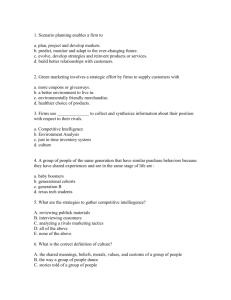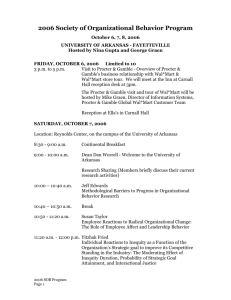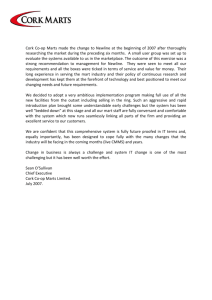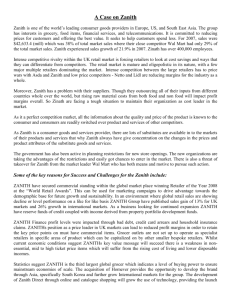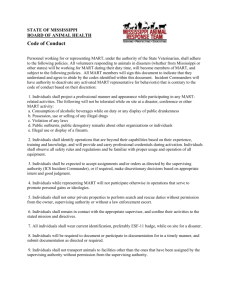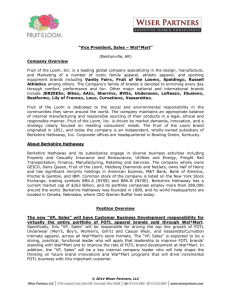1 Wal-Mart: Always Low Prices Means Always Low Wages
advertisement
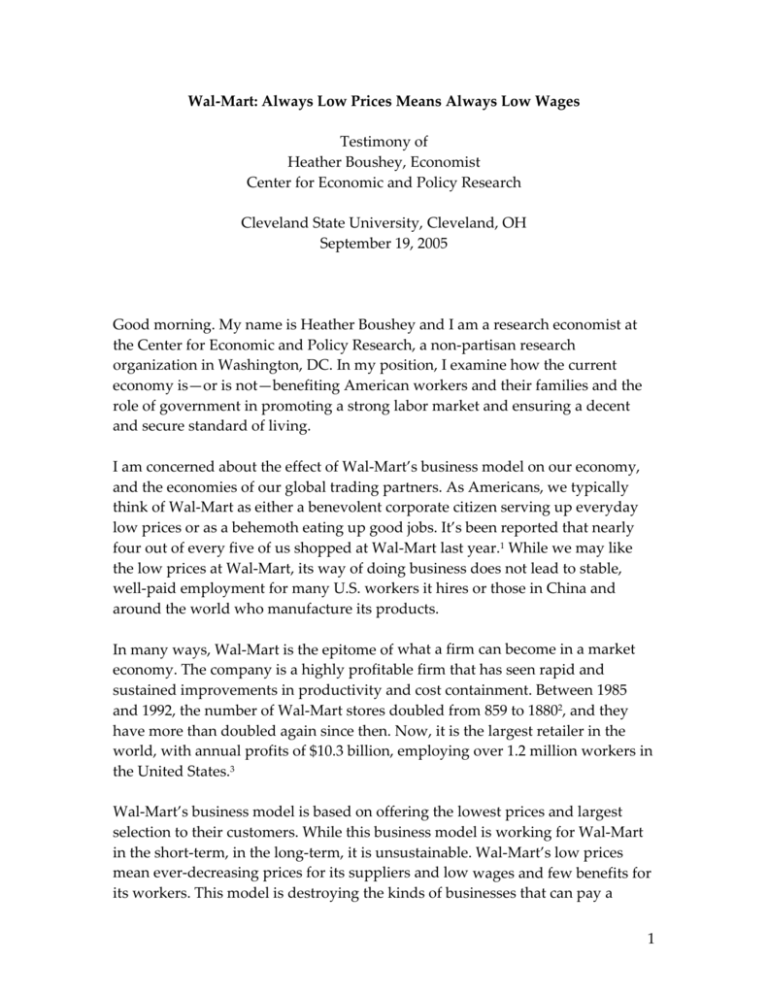
Wal‐Mart: Always Low Prices Means Always Low Wages Testimony of Heather Boushey, Economist Center for Economic and Policy Research Cleveland State University, Cleveland, OH September 19, 2005 Good morning. My name is Heather Boushey and I am a research economist at the Center for Economic and Policy Research, a non‐partisan research organization in Washington, DC. In my position, I examine how the current economy is—or is not—benefiting American workers and their families and the role of government in promoting a strong labor market and ensuring a decent and secure standard of living. I am concerned about the effect of Wal‐Mart’s business model on our economy, and the economies of our global trading partners. As Americans, we typically think of Wal‐Mart as either a benevolent corporate citizen serving up everyday low prices or as a behemoth eating up good jobs. It’s been reported that nearly four out of every five of us shopped at Wal‐Mart last year.1 While we may like the low prices at Wal‐Mart, its way of doing business does not lead to stable, well‐paid employment for many U.S. workers it hires or those in China and around the world who manufacture its products. In many ways, Wal‐Mart is the epitome of what a firm can become in a market economy. The company is a highly profitable firm that has seen rapid and sustained improvements in productivity and cost containment. Between 1985 and 1992, the number of Wal‐Mart stores doubled from 859 to 18802, and they have more than doubled again since then. Now, it is the largest retailer in the world, with annual profits of $10.3 billion, employing over 1.2 million workers in the United States.3 Wal‐Mart’s business model is based on offering the lowest prices and largest selection to their customers. While this business model is working for Wal‐Mart in the short‐term, in the long‐term, it is unsustainable. Wal‐Mart’s low prices mean ever‐decreasing prices for its suppliers and low wages and few benefits for its workers. This model is destroying the kinds of businesses that can pay a 1 living wage, and in the process, the lives of workers here in the United States and around the world. Wal‐Mart is what unfettered capitalism looks like. Or, more honestly, this is what a company can achieve with governments subsidies and limited regulation. Wal‐ Mart has received billions in direct and indirect subsidies—from economic development subsidies and tax breaks, to subsidies to their low‐paid workers, who receive Medicaid, food stamps and the EITC. Wal‐Mart. On the other hand, Wal‐Mart has spurned regulation and regularly violated labor, environmental, and safety and health laws. We should all care about what Wal‐Mart’s business model and watch carefully both because of the immediate consequences as well as its influence as the new standard for other firms to emulate. If every firm engages in an unregulated race to the bottom, we will soon find that there is no one left able to purchase the goods our economy can produce. Wal‐Mart’s Business Model: Always Low Prices, Always Low Wages Wal‐Mart’s business model is “always low prices.” Wal‐Mart achieves low prices by cutting costs in all aspects of their trade. They have effectively focused on increasing their productivity, keeping wages low for their employees, maintaining pressure on suppliers to keep their prices down, and lobbying government—at all levels—for increased access to international suppliers and limited regulation at the local level. Wal‐Mart has increased productivity internally by keeping its stores connected to its distribution centers and suppliers.4 Further, they keep inventories at a minimum by requiring that supplies strictly maintain their scheduled deliveries. By now, it is common knowledge that Wal‐Mart employees are paid relatively low wages and offered few, if any, benefits. Amy Hanauer, of Policy Matters Ohio, will discuss the effects of low wages and limited benefits on public coffers, but I’d like to point out a few statistics that shed light on Wal‐Mart’s remuneration practices: • Wal‐Mart workers earn about one quarter less than other retail workers, taking home an average of $19,226 in 2004, compared to $24,647 among all large retailers. Wal‐Mart’s hourly employees earn less, only $17,285. 2 • • • 1.4 million women claim to have been discriminated against in pay and promotions are currently suing Wal‐Mart. This is the largest class action suit in U.S. history.5 Less than half of employees (41 to 46 percent, depending on the source) are covered by Wal‐Mart’s health plan, compared to over 60 percent of workers nationwide and 68 percent among large employers. Wal‐Mart employees who have health insurance must pay for one‐third of the cost of their health insurance, far higher than workers at other large firms.6 But, low wages and lack of benefits at home are not only a problem for Wal‐ Mart’s employees. Wal‐Mart’s business practices also foster low wages for workers abroad at companies that supply Wal‐Mart’s products. Wal‐Mart’s business model requires keeping supply costs down, which means that they constantly put pressure on their suppliers to cut their prices, thus, requiring that they adopt Wal‐Mart’s business model as well. Fast Company reported that Wal‐Mart demands that the price must fall each year for products that do not change.7 This creates the need for continual cost reductions by its suppliers. Wal‐Mart can demand this precisely because it’s the largest retailer in the United States. Wal‐Mart’s suppliers do not often benefit from their relationship to the retailer. According to Bain and Company, from a study of 38 companies with high exposure to Wal‐Mart, suppliers selling 10 percent of their volume or more to Wal‐Mart had an average earnings margin, before interest and tax, of 12.7 percent. However, among dedicated suppliers, the figure falls to 7.3 percent, which may be beneficial overall if they have a sufficiently large enough gain in volume.8 Implications of the Wal‐Mart Business Model The combined effect of “always low prices” has been positive for consumers only concerned with lower prices, but negative for workers, small businesses, and democracy. Low Wages At Home … 3 There are ongoing discussions in the United States about the effects of Wal‐ Mart’s low wages on retail workers. You’ll hear more about this later today, as well as the dampening effect of Wal‐Mart on labor organizing. The effects of Wal‐Mart on retail workers and domestic suppliers are painfully apparent to those who to take the time to look. Wal‐Mart’s business model does bring prices down. A study of 165 cities between 1982 and 2002 found that the entry of Wal‐Mart led to retail prices falling by 1.5 to 3.0 percent in the short‐run to four times as much in the long‐ run.9 But, Wal‐Mart’s business model also has a host of undesirable effects. The entry of Wal‐Mart into a community is associated with, among other things, losses of small, family‐owned business, 10 a higher growth of poverty (or slower declines in poverty reduction), 11 greater expenditures of public benefits for low‐wage workers,12 and environmental degradation.13 Wal‐Mart does create jobs. But, as I mentioned above these jobs are generally not well‐paid, and, the total number of jobs created, after discounting the local jobs destroyed, is actually quite small. In a recent paper, Emek Basker finds that Wal‐ Mart’s entry into a community in the United States increases retail employment by 100 jobs in the first year, but 50 of those jobs disappear over the next five years. Wholesale employment declines by approximately 20 jobs due to Wal‐ Mart’s vertical integration, but no spillover effect is detected in retail areas that Wal‐Mart does not compete in.14 … And Abroad Wal‐Mart’s business model also has had a profound effect on manufacturing production and labor conditions, both in the United States and abroad. Wal‐Mart has been accused of using sweatshops to supply its goods. In 1993, Dateline NBC aired a segment about goods made by child workers in Bangladesh being sold under the Wal‐Mart private label; they aired a similar story in 2005. Ironically, from 1985 until 1993, Wal‐Mart had promoted its “Buy American” campaign, in the midst of growing consumer anxiety about Asian imports. As late as March 1992, Wal‐Mart CEO David Glass told Business Week that he would pay up to a 5 percent premium for U.S‐made goods. 4 The reality is that Wal‐Mart is now China’s eighth largest trading partner and accounts for 10 percent of China’s imports to the United States. It is estimated that 70 percent of Wal‐Mart’s products are now produced in China. About half of those imports are direct while the rest comes through suppliers.15 Wal‐Mart did not invent outsourcing and did not instigate the long downward slide of U.S. manufacturing. But, in recent years, they have significantly contributed to the movement away from U.S. manufacturers to overseas suppliers. But, for Wal‐Mart, products can never be cheap enough and Wal‐Mart continues to flout even its own paltry standards for basic pay and benefits. This past Wednesday, September 14, the International Labor Rights Fund filed a suit on behalf of hundreds of thousands of factory workers in China, Bangladesh, Indonesia, Swaziland, and Nicaragua, as well as California workers at Ralphs and Safeway grocery stores who claimed that they were hurt by Wal‐Mart. The suit contends that Wal‐Mart has failed to enforce its own corporate code of conduct for its supplies by not mandating basic wage and working conditions. It claims that the California workers were hurt by Wal‐Mart’s forcing other grocery stores to lower wages and benefits.16 Government: Always Helping Wal‐Mart? Wal‐Mart’s business model depends on limited government regulation of its labor practices and business methods, along with subsidies for its infrastructure development and to support the living standards of its poorly paid workers. Wal‐Mart regularly violates environmental, safety, health, and labor rights standards. Wal‐Mart actively pursues “Wal‐Mart‐friendly” policies in national, state and international capitals in its attempts to undermine locally‐ and nationally‐ controlled regulatory structures. The Center for Public Integrity reports that Wal‐ Mart has spent $4,590,000 lobbying Congress between 1998 and 2004, spending $1,160,000 in 2004 alone.17 Good Jobs First has extensively documented how Wal‐Mart uses public subsidies to finance its expansion into communities around the United States. They document that Wal‐Mart has received—at a minimum—more than $1 billion in economic development subsidies from state and local government.18 5 As Wal‐Mart looks to expand internationally and increasingly import their goods, Wal‐Mart has focused on international trade agreements. A typical Wal‐ Mart action is lobbying the U.S. Trade Representative’s Office to reduce quotas on textile imports from China.19 Further, Wal‐Mart has become increasingly active at lobbying diplomats at the World Trade Organization to pressure governments to commit to ever‐ expanding WTO constraints on how zoning policy can be used, as Public Citizen’s Global Trade Watch documents in an upcoming report. One example of this WTO / big‐box store alliance in action came when the U.S. Trade Representative mounted a WTO assault on Japan’s Large‐Scale Retail Law, which gave incentives for smaller retailers to stay in business. By using obscure rules under the services agreement of the WTO, the U.S. argued that requiring foreign big box stores to even attend community hearings was an unnecessary barrier to market access in services trade. More recent documents show that Wal‐Mart, along with international retailing federations that are targeting U.S. regulations, see eliminating governments’ ability to use zoning policy as a major goal for the ongoing WTO negotiations. If Wal‐Mart has its way, communities will not be able to regulate Wal‐Mart stores, suppliers, or the conditions under which workers toil. Are We Doomed to Always Low Wages? Wal‐Mart’s business model represents a break in past tradition. While this business model – low prices, low wages – is not especially unique, no large employer in the United States has adopted this model with such resounding success. In the mid‐twentieth century, the Fordist business model prevailed, which was based on a social contract between workers and employers and an understanding that it is the workers who are, in the end, the customers. Wal‐Mart does not recognize that customers are workers and that a business model based on squeezing wages limits demand for the very products that these workers produce. 6 But, therein lies the answer: Wal‐Mart’s business model is not just “always low prices”, but rather, it is marketed to families who are “pinched,” scraping to meet their family budget. Wal‐Mart grew up during a long swing of declining inflation‐adjusted wages for the typical male worker. Family incomes were flat and the only reason that they did not fall was that women went to work in large numbers, bolstering family income, while creating a time crunch at home. This was a period of union decline, movement toward less government regulation of business practices, and declining U.S. manufacturing. Wal‐Mart shoppers needed a bargain. But, creating an economy based on low wages is not a bargain in the long‐run. Because of its prominence as an employer and a retailer, Wal‐Mart’s business model—both its labor practices and its relationships with suppliers—are likely to be emulated by other companies out of necessity or admiration. Wal‐Mart’s business model is bad for workers, but it’s also bad for citizens. While Wal‐Mart pushes for less regulation and “free markets,” they bully local governments for subsidies and shift the costs of its workers’ well‐being on to state and national budgets. Without enforcement of current laws and regulation to ensure a decent standard of living for workers here and abroad, our entire economy will someday look like Wal‐Mart. Anthony Bianco and Wendy Zellner, “Is Wal‐Mart Too Powerful?” Business Week, October 6, 2003. 2 Emek Basker and Pham Hoang Van, “Putting a Smiley Face on the Dragon: Wal‐Mart as a Catalyst to U.S.‐China Trade,” University of Missouri Working Paper, July 2005. 3 Annette Bernhardt, Anmol Chaddha, and Siobhán McGrath. “What Do We Know About Wal‐ Mart?” Brennan Center for Justice, Economic Policy Brief No. 2, August 2005. 4 In late 1990, Wal‐Mart introduced Retail Link, software that connected its stores, distribution centers, and suppliers. 5 Liza Featherstone, Selling Women Short: The Landmark Battle for Workers’ Rights at Wal‐Mart, New York: Basic Books, 2004. 6 Annette Bernhardt, Anmol Chaddha, and Siobhán McGrath. “What Do We Know About Wal‐ Mart?” Brennan Center for Justice, Economic Policy Brief No. 2, August 2005. 7 Charles Fishman, “The Wal‐Mart You Don’t Know” Fast Company, Issue 77, December 2003, p. 68. 8 Amy Balchin, “Winning with Wal‐Mart Home Office,” The Grocer Vol. 227, no. 7666, August 7, 2004, p. 28. 9 Emek Basker, “Selling a Cheaper Mousetrap: Wal‐Mart’s Effect on Retail Prices,” Journal of Urban Economics, forthcoming 2005. 10 Ikenneth Stone, Georgeanne Artz, and Albert Myles. The Economic Impact of Wal‐Mart Supercenter on Existing Businesses in Mississippi. Starkville, MS: Mississippi State University, 2002. 1 7 Stephen Goetz, and Hema Swaminthan, Wal‐Mart and County‐Wide Poverty. University Park, PA: Pennsylvania State University, Department of Agricultural Economics and Rural Sociology, 2004. Staff Paper No. 371. 12 Arindraji Dube and Ken Jacobs, Hidden Cost of Low‐Wage Jobs: Use of Safety Net Programs by Wal‐ Mart Workers in California, University of California Labor Center Briefing Paper, August 2, 2004. 13 For example, in 2004, Wal‐Mart was fined $3.1 million for environmental violations in nine states. They have violated the Clean Air Act, the Clean Water Act. See <www.walmartwatch.com>. 14 Emek Basker, “Job Creation or Destruction? Labor –Market Effects of Wal‐Mart Expansion,” Review of Economics and Statistics Vol. 87, no. 1 (2005), p. 174‐83. 15 Emek Basker and Pham Hoang Van, “Putting a Smiley Face on the Dragon: Wal‐Mart as a Catalyst to U.S.‐China Trade,” University of Missouri Working Paper, July 2005. The 70% figure is cited from: J. Jjiang, “Wal‐Mart’s China Inventory to Hit U.S.818 Billion,” China Business Weekly, November 30, 2004. 16 Molly Selvin, “Wal‐Mart Faces Suit by Labor Group,” Los Angeles Times, September 14, 2005, Business Desk, Part C, p. 3. 17 http://www.publicintegrity.org/lobby/profile.aspx?act=clients&year=2003&cl=L003120. Wal‐ Mart has also given soft money == http://www.opensecrets.org/softmoney/softcomp1.asp?txtName=Wal‐Mart. “Retail industry” more generally ‐‐ http://www.opensecrets.org/industries/indus.asp?Ind=N03 18 Philip Mattera and Anna Purinton, with Jeff McCourt, Doug Hoffer, Stephanie Greenwood and Alyssa Talanker, Shopping for Subsidies: How Wal‐Mart Uses Taxpayer Money to Finance Its Never‐ Ending Growth, Good Jobs First, May 2004. 19 Kristi Ellis, “U.S. China to Discuss Long‐Term Trade Deal,” Women’s Wear Daily, Friday August 12, 2005. 11 8

